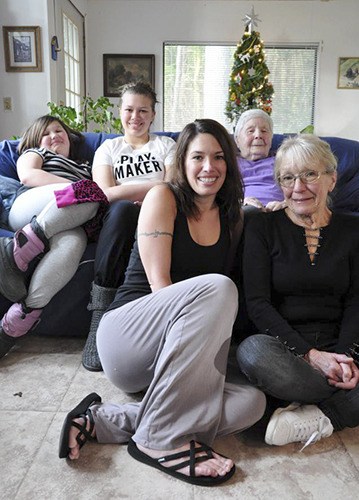By Gretchen Wing
When you’ve lived nearly a century, you appreciate the big picture. At 99 the oldest living Lopezian (unofficially, but how official does Lopez need to get?), Nona Idelle Johnson notices the parallels between these days and those of her youth. “You had to work like heck [back then] to make a living, and some of ‘em couldn’t,” she says. “For some of ‘em now, it’s just as hard as during the Depression.”
 Nona can relate deeply to this similarity. One of her grandchildren is currently moving from Lopez to Arizona following job opportunities, just as her own parents migrated to the small town of Terrace, near Wenatchee, from the Midwest early in the last century. Nona was born January First, 1915, and came of age during the 1930s. With admiration, she remembers Dust Bowl migrants from Arkansas, comparing them to the Mexican farmworkers populating eastern Washington today. “You gotta have something in you to get yourself to a whole new part of the country,” she says. She also appreciates how, over the past century, opportunities for women have expanded, with “more different kinds of jobs they can do now.” When you’re ninety-nine, history is personal.
Nona can relate deeply to this similarity. One of her grandchildren is currently moving from Lopez to Arizona following job opportunities, just as her own parents migrated to the small town of Terrace, near Wenatchee, from the Midwest early in the last century. Nona was born January First, 1915, and came of age during the 1930s. With admiration, she remembers Dust Bowl migrants from Arkansas, comparing them to the Mexican farmworkers populating eastern Washington today. “You gotta have something in you to get yourself to a whole new part of the country,” she says. She also appreciates how, over the past century, opportunities for women have expanded, with “more different kinds of jobs they can do now.” When you’re ninety-nine, history is personal.
Nona Ives met Peter Johnson working in the apple orchards when both were still teenagers. They married in 1938, at the Depression’s height, and their family of five began only a year later, spanning the war years. “Those days you went where the work was,” Nona says, so the family migrated to coastal Washington and moved around. Peter drove a truck, laid pipe, and did whatever job came his way to give Nona something to feed the family with. When the war began, a collarbone injury kept Peter out of the military, but the work stayed hard. Still, Nona makes no complaints. Her youngest daughter, Cheryl Johnson, participating in the interview, remembers ration stamp-books and tokens from the war years, but Nona sticks with the big picture: they made do.
Life isn’t all about hard work, though: another fundamental Nona understands. Her mother was a music teacher, and Nona and Cheryl relate the story of how she had her piano shipped from Minnesota, all the way around the horn of South America (in those pre-canal days) and up the Columbia River. There, the piano-carrying boat may or may not have wrecked—depending on whose version you prefer—but the piano was saved, and the message is clear: following one’s passion matters.
Nona’s is cooking. “She loves to make soup, and bread,” says Cheryl. Although her mom self-deprecates her skills, Cheryl tells the story of bringing some homemade cake in her school lunch one day, and having the Home Economics teacher ask for a taste…and next, the recipe. “Mom said, ‘Well, it’s just a pinch of this and a pinch of that,’” Cheryl laughs; Nona never bothered to write her recipes down.
Indirectly, Nona’s love for cooking is what brought her to Lopez. Around ten years ago, Nona moved into an assisted living facility in Stanwood with her sister. But the place offered no cooking facilities, and Nona was not ready to be waited on. “I didn’t want that,” she says. The family encouraged Nona to move to Lopez, where Cheryl had been living since the mid-nineties, and Nona’s eldest son, Jan Johnson, owned the Islandale Store. They got her settled, comfortable and independent, in a home not far from the store. Photos from her ever-expanding progeny decorate the house, but many family members are only a short drive away, because Nona now shares Lopez with three succeeding generations. Besides Jan and his wife Ingrid and daughter Tisha, there are granddaughters Cadynce and Camden. Then Cheryl has her daughter Kira, and Kira has Alexa and Ava. And that’s not even to mention all the cousins.
These branches of the family tree share another trait besides locality: a name. When Nona was trying to decide what middle name to give Cheryl, her mother said, “Why don’t you give her yours?” Thus: Nona Idelle Johnson. Cheryl Idelle Johnson. Kira Idelle Gates. Alexa Idelle Ogden. The name strengthens the generational bond.
Nona’s family has seen its share of hard times. In 1960, she lost her husband Peter during a botched surgery. Two decades later, she lost a son to lymphoma. But Nona remains vibrant. A discussion with Cheryl over the number of her great-grandchildren yields a lengthy storm of generational arithmetic. Clearly, the correct answer (eleven?) is less important than the process itself, each recited name renewing the connections. That’s the big picture.



